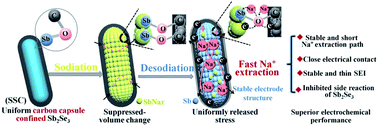Carbon capsule confined Sb2Se3 for fast Na+ extraction in sodium-ion batteries†
Abstract
Pulverization is a common phenomenon of alloy-based anode materials during the sodiation/desodiation process and usually leads to sluggish Na+ insertion/extraction kinetics. Although many studies have reported how to avoid or inhibit the occurrence of this phenomenon, it is still a great challenge in the research on alloy-based anode materials. Herein, we have achieved fast Na+ extraction in an Sb2Se3 alloy anode by constructing uniform carbon capsule confined Sb2Se3 composites (SSCs). Further analysis results indicate that the fast Na+ extraction is attributed to the uniform carbon capsule confined Sb2Se3 structure. In this structure, the carbon capsule can suppress the huge volume change of Sb2Se3 during the Na+ insertion process and uniformly release stress during the Na+ extraction process, maintaining the stable electrode structure. Specifically, Sb2Se3 is in situ pulverized in the intact carbon capsule and maintains the original rod-like outline, which provides a stable and short Na+ extraction pathway, good electrical contact, and a stable SEI layer on the surface of the intact carbon capsule and inhibits the side reaction of Sb2Se3. Therefore, the SSC exhibits fast Na+ extraction with a high reversible capacity of 324 mA h g−1 at 5 A g−1. The capacity is still as high as 380 mA h g−1 after 600 cycles at 2 A g−1.



 Please wait while we load your content...
Please wait while we load your content...